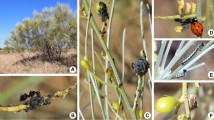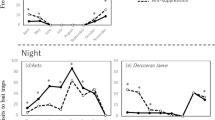Abstract
Based on the well-known mutualism between ants (Hymenoptera: Formicidae) and aphids (Homoptera: Aphididae), we conducted a five-year experiment of ant-exclusion from the canopies of citrus trees as a possible method of biological control of aphids. However, our results showed that the exclusion of ants from the canopies increased, instead of reducing, aphid abundance. To explain this unexpected result, we reasoned that the exclusion of ants from the canopies might also have excluded crawling insects that prey on aphids, such as the European earwig (Forficula auricularia L., Dermaptera: Forficulidae). Such a possibility is supported by the negative relationship between aphid density and the abundance of earwigs, consistent with a top-down control of aphids by earwigs. In contrast, the abundance of other aphid predators (Coleoptera: Coccinellidae, and Heteroptera) had no such negative effect on aphid density but a positive one, suggesting a bottom-up control, and showed no differences between control and ant-excluded trees. Thus, the most likely explanation for the increase in aphid abundance in the ant-excluded trees is the absence of earwigs from the canopies of the experimental trees, providing further evidence of the major role that earwigs play as control agents of aphids in cultivated trees.





Similar content being viewed by others
References
Asgari A (1966) Unterschungen über die im Raum Stuttgart–Hohenheim als wichtigste Prädatoren der grünen Apfelblattlaus (Aphidula pomi Deg.) auftretenden Arthropoden. Z Angew Zool 53:35–93
Baoua Boukary I, Gingras J, Tourneur J-C (1997) Feeding habits of Forficula senegalensis (Derm: Forficulidae) on millet in the Sudanese-Sahelian zone of Niger: crop content analysis. Entomophaga 42:537–542
Barbagallo S, Cravedi P, Pasqualini E, Patti I (1998) Pulgones de los principales cultivos frutales. Ediciones Mundi-Prensa, Madrid
Bartlett BR (1961) The influence of ants upon parasites, predators, and scale insects. Ann Entomol Soc Am 54:543–551
Beattie AJ (1985) The evolutionary ecology of ant-plant mutualisms. Cambridge University Press, Cambridge
Bernard F (1967) Faune de l’Europe et du Bassin Méditerranéen. 3. Les fourmis (Hymenoptera Formicidae) d’Europe occidentale et septentrionale. Ed. Masson, Paris
Blackman RL, Eastop VF (2000) Aphids on the world’s crops. An identification guide, 2nd edn. Wiley, England
Blommers LHM (1994) Integrated pest management in European apple orchards. Annu Rev Entomol 39:213–241
Bristow CM (1991) Why are so few aphids ant-tended? In: Huxley CR, Cutler DF (eds) Ant-plant interactions. Oxford University Press, New York, pp 104–119
Bronstein JL (1994) Conditional outcomes in mutualistic interactions. Trends Ecol Evol 9:214–217
Buckley RC (1987) Interactions involving plants, Homoptera, and ants. Annu Rev Ecol Syst 18:111–135
Buxton JH, Madge DS (1976) The food of the European earwig (Forficula auricularia L.) in Hop gardens. Entomol Mon Mag 112:231–237
Cañellas N, Piñol J, Espadaler X (2005) Las tijeretas (Dermaptera, Forficulidae) en el control del pulgón en cítricos. Bol Sanid Veg Plagas 31:161–169
Carroll DP, Hoyt SC (1984) Augmentation of European earwigs (Dermaptera: Forficulidae) for biological control of apple aphid (Homoptera: Aphididae) in an apple orchard. J Econ Entomol 77:738–740
Collingwood CA (1978) A survey of Iberian Formicidae (Hymenoptera) with a key to worker caste. Eos 52:65–95
Crawley MJ (2007) The R book. Wiley, Chichester
Cross JV, Solomon MG, Babendreier D, Blommers L, Easterbrook MA, Jay CN, Jenser G, Jolly RL, Kuhlmann U, Lilley R, Olivella E, Toepfer S, Vidal S (1999) Biocontrol of pests of apples and pears in Northern and Central Europe—2. Parasitoids. Biocontrol Sci Tech 3:277–314
Daane KM (2001) Ecological studies of released lacewings in crops. In: McEwen P, New TR, Whittington AE (eds) Lacewings in the crop environment. Cambridge University Press, Cambridge, pp 338–350
Dixon AFG (1998) Aphid ecology. Chapman & Hall, London
Forel A (1920) Les fourmis de la Suisse. Notices anatomiques et physiologiques, architecture, distribution géographique, nouvelles expériences et observations de moeurs. Seconde édition revue et corrigée. Imprimerie Coopérative. La Chaux-de-Fonds
García Prieto F, Tinaut Ranera A, Pérez Hidalgo N, Nieto Nafría JM (2005) Apéndice 3. Relaciones pulgón/hormiga y hormiga/pulgón. In: Ramos Sánchez MA, Alba Tercedor J, Bellés Ros X, Gosálbez Noguera J, Guerra Sierra A, Macpherson Mayol E, Martín Piera F, Serrano Marino J, Templado González J (eds) Hemiptera, Aphiidae III. Fauna Ibérica, vol 28. Museo Nacional de Ciencias Naturales. CSIC, Madrid, pp 345–350
González-Hernández H, Johnson MW, Reimer NJ (1999) Impact of Pheidole megacephala (F.) (Hymenoptera: Formicidae) on the biological control of Dysmicoccus brevipes (Cockerell) (Homoptera: Pseudococcidae). Biol Control 15:145–152
Haas F (2004) Fauna Europaea: Forficulidae. In: Heller KG (ed) Fauna Europaea: orthopteroid orders. Fauna Europaea version 1.1, http://www.faunaeur.org
Halaj J, Ross DW, Moldenke AR (1997) Negative effects of ant foraging on spiders in Douglas-fir canopies. Oecologia 109:313–322
Heil M, McKey D (2003) Protective ant-plant interactions as model systems in ecological and evolutionary research. Ann Rev Ecol Evol Syst 34:425–453
Hermoso de Mendoza A, Belliure B, Carbonell EA, Real V (2001) Economic thresholds for Aphis gossypii (Hemiptera: Aphididae) on Citrus clementina. J Econ Entomol 94:439–444
Houdková K, Kindlmann P (2006) Scaling up population dynamic processes in a ladybird-aphid system. Popul Ecol 48:323–332
James DG, Stevens MM, O’Malley KJ (1997) The impact of foraging ants on populations of Coccus hesperidium L. (Hem., Coccidae) and Aonidiella aurantii (Maskell) (Hem., Diaspididae) in an Australian citrus grove. J Appl Entomol 121:257–259
James DG, Stevens MM, Faulder RJ (1999) Ant foraging reduces the abundance of beneficial and incidental arthropods in citrus canopies. Biol Control 14:121–126
Kaneko S (2003) Different impacts of two species of aphid-attending ants with different aggressiveness on the number of emerging adults of the aphid’s primary parasitoid and hyperparasitoids. Ecol Res 18:199–212
Kaplan I, Eubanks MD (2002) Disruption of cotton aphid (Homoptera: Aphididae)—natural enemy dynamics by red imported fire ants (Hymenoptera: Formicidae). Environ Entomol 31:1175–1183
Llorens J (1990) Homoptera II. Pulgones de los cítricos y su control biológico. Pisa Ediciones, Alicante
Mansour F, Whitecomb WH (1986) The spiders of a citrus grove in Israel and their role as biocontrol agents of Ceroplastes floridensis (Homoptera: Coccidae). Entomophaga 31:269–276
McQueen DJ, Johannes MRS, Post JR, Stewart TJ, Lean DRS (1989) Bottom-up and top-down impacts on freshwater pelagic community structure. Ecol Monogr 59:289–309
Nicholas AH, Spooner-Hart RN, Vickers RA (2005) Abundance and natural control of the woolly aphid Eriosoma lanigerum in an Australian apple orchard IPM program. BioControl 50:271–291
Nieto Nafría JM, Mier Durante MP, García Prieto F, Pérez Hidalgo N (2005) Hemiptera, Aphididae III. In: Ramos Sánchez MA, Alba Tercedor J, Bellés Ros X, Gosálbez Noguera J, Guerra Sierra A, Macpherson Mayol E, Martín Piera F, Serrano Marino J, Templado González J (eds) Fauna Ibérica, vol 28. Museo Nacional de Ciencias Naturales. CSIC, Madrid
R Development Core Team (2006) R: a language and environment for statistical computing. R Foundation for Statistical Computing, Vienna, Austria. ISBN 3-900051-07-0, URL http://www.R-project.org
Retana J, Cerdá X, Espadaler X (1992) Coexistence of two sympatric ant species, Pheidole pallidula and Tetramorium semilaeve (Hymenoptera: Formicidae). Entomol Gen 17:29–40
Ribes J, Piñol J, Espadaler X, Cañellas N (2004) Heterópteros de un cultivo ecológico de cítricos de Tarragona Cataluña, NE España (Hemiptera, Heteroptera). Orsis 19:21–35
Samways MJ, Tate BA (1985) A highly efficacious and inexpensive trunk barrier to prevent ants from entering citrus trees. Citrus Subtrop Fruit J 618:12–13, 18
Skinner GJ, Whittaker JB (1981) An experimental investigation of interrelationships between the wood and Formica rufa and some tree canopy herbivores. J Anim Ecol 50:313–326
Solomon MG, Cross JV, Fitzgerald JD, Campbell CAM, Jolly RL, Olszak RW, Niemczyk E, Voght H (2000) Biocontrol of pests of apples and pears in Northern and central Europe—3. Predators. Biocontrol Sci Tech 10:91–128
Steyn JJ (1954) The effect of the cosmopolitan brown house ant (Pheidole megacephala F.) on citrus red scale (Aonidiella aurantii Mask.) at Letaba. J Entomol Soc S Afr 17:252–264
Styrsky JD, Eubanks ED (2007) Ecological consequences of interactions between ants and honeydew-producing insects. Proc R Soc B 274:151–164
Suay-Cano VA, Tinaut A, Selfa J (2002) Las hormigas (Hymenoptera, Formicidae) asociadas a pulgones (Homoptera, Aphididae) en la provincia de Valencia. Graellsia 58:21–37
Suckling DM, Burnip GM, Hackett J, Daly JC (2006) Frass sampling and baiting indicate European earwig (Forficula auricularia) foraging in orchards. J Appl Entomol 130:263–267
Sunderland KD (1988) Carabidae and other invertebrates. In: Minks AK, Harrewijn P (eds) World crop pests. Aphids their biology, natural enemies and control, vol 2B. Elsevier, Amsterdam, pp 293–310
Sunderland KD, Crook NE, Stacey DL, Fuller BJ (1987) A study of feeding by polyphagous predators on cereal aphids using Elisa and gut dissections. J Appl Ecol 24:907–933
Szentkirályi F (2001) Lacewings in fruit and nut crops. In: McEwen P, New TR, Whittington AE (eds) Lacewings in the crop environment. Cambridge University Press, Cambridge, pp 172–238
Völkl W (1992) Aphids and their parasitoids: who actually benefits from ant-attendance? J Anim Ecol 61:273–281
Walde SJ, Nyrop JP, Hardman JM (1992) Dynamics of Panonychus ulmi and Typhlodromus pyri: factors contributing to persistence. Exp Appl Acarol 14:261–291
Way MJ (1963) Mutualism between ants and honeydew-producing Homoptera. Annu Rev Entomol 8:307–344
Worm B, Myers RA (2003) Meta-analysis of cod-shrimp interactions reveals top-down control in oceanic food-webs. Ecology 84:162–173
Acknowledgments
Sincere thanks to Pere Cañellas and Núria Mas for permission to conduct field research on their land and to Cristina Delgado for helping us in the field work. Heteropterans were identified by Jordi and Eva Ribes and Coccinellidae by Pep Muñoz. We thank Jordi Martínez-Vilalta, Daniel Sol and three anonymous reviewers for valuable discussions and comments on the paper, and David Owen for revising the English language. This work has been supported by grants from MEC-FEDER (CGL2004-05240-C02-01/BOS and CGL2007-64080-C02-01).
Author information
Authors and Affiliations
Corresponding author
Additional information
Handling Editor: Eric Lucas.
Rights and permissions
About this article
Cite this article
Piñol, J., Espadaler, X., Cañellas, N. et al. Effects of the concurrent exclusion of ants and earwigs on aphid abundance in an organic citrus grove. BioControl 54, 515–527 (2009). https://doi.org/10.1007/s10526-008-9203-8
Received:
Accepted:
Published:
Issue Date:
DOI: https://doi.org/10.1007/s10526-008-9203-8




